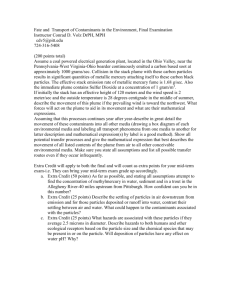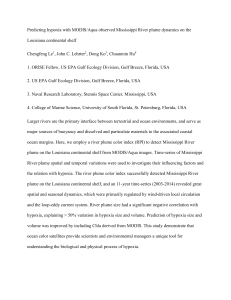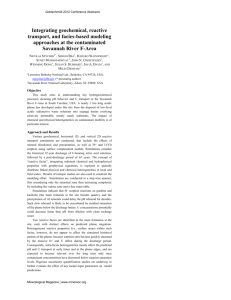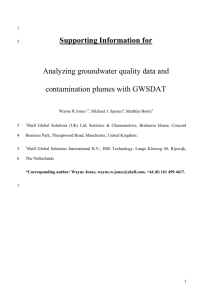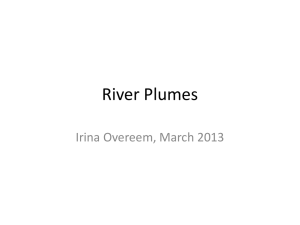a comparison of optical spectroscopic and conventional
advertisement
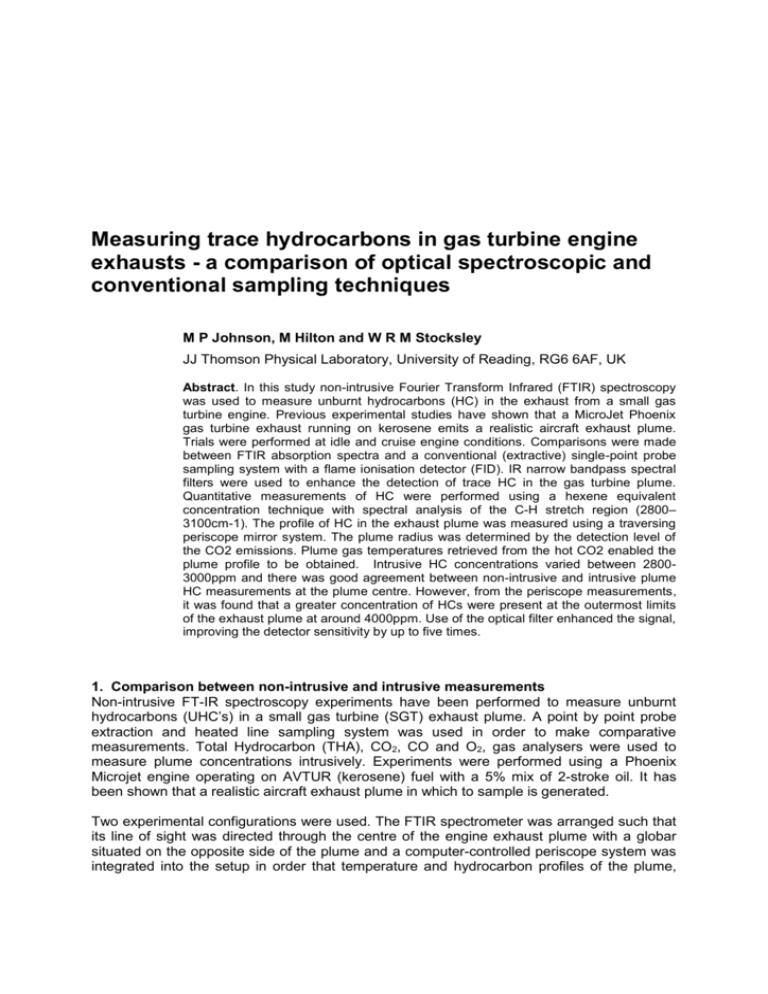
Measuring trace hydrocarbons in gas turbine engine exhausts - a comparison of optical spectroscopic and conventional sampling techniques M P Johnson, M Hilton and W R M Stocksley JJ Thomson Physical Laboratory, University of Reading, RG6 6AF, UK Abstract. In this study non-intrusive Fourier Transform Infrared (FTIR) spectroscopy was used to measure unburnt hydrocarbons (HC) in the exhaust from a small gas turbine engine. Previous experimental studies have shown that a MicroJet Phoenix gas turbine exhaust running on kerosene emits a realistic aircraft exhaust plume. Trials were performed at idle and cruise engine conditions. Comparisons were made between FTIR absorption spectra and a conventional (extractive) single-point probe sampling system with a flame ionisation detector (FID). IR narrow bandpass spectral filters were used to enhance the detection of trace HC in the gas turbine plume. Quantitative measurements of HC were performed using a hexene equivalent concentration technique with spectral analysis of the C-H stretch region (2800– 3100cm-1). The profile of HC in the exhaust plume was measured using a traversing periscope mirror system. The plume radius was determined by the detection level of the CO2 emissions. Plume gas temperatures retrieved from the hot CO2 enabled the plume profile to be obtained. Intrusive HC concentrations varied between 28003000ppm and there was good agreement between non-intrusive and intrusive plume HC measurements at the plume centre. However, from the periscope measurements, it was found that a greater concentration of HCs were present at the outermost limits of the exhaust plume at around 4000ppm. Use of the optical filter enhanced the signal, improving the detector sensitivity by up to five times. 1. Comparison between non-intrusive and intrusive measurements Non-intrusive FT-IR spectroscopy experiments have been performed to measure unburnt hydrocarbons (UHC’s) in a small gas turbine (SGT) exhaust plume. A point by point probe extraction and heated line sampling system was used in order to make comparative measurements. Total Hydrocarbon (THA), CO2, CO and O2, gas analysers were used to measure plume concentrations intrusively. Experiments were performed using a Phoenix Microjet engine operating on AVTUR (kerosene) fuel with a 5% mix of 2-stroke oil. It has been shown that a realistic aircraft exhaust plume in which to sample is generated. Two experimental configurations were used. The FTIR spectrometer was arranged such that its line of sight was directed through the centre of the engine exhaust plume with a globar situated on the opposite side of the plume and a computer-controlled periscope system was integrated into the setup in order that temperature and hydrocarbon profiles of the plume, that is, the spatial distributions, could be obtained. The periscope was incorporated into the system as shown in Figure 1. Figure 1 Setup of the periscope system. Analysis of the total UHC concentrations in the exhaust plume was calculated from absorption spectra. The absorbance from the UHC’s in the engine plume was determined by taking the natural logarithm of the ratio of the emissivity at two peaks in the absorption spectra. These two peaks were established from an exhaust absorption spectrum, with the specific UHC filter positioned within the spectrometer. This optical filter (bandpass JSD Uniphase) passes IR radiation only within the 2700–3150cm-1 (3.20-3.59m) band, and when used while scanning the engine exhaust plume in absorption with the external globar, produces a spectrum as shown in Figure 2. The absorbance was normalised such that the emissivity at the 2817cm-1 peak (point I0 in Figure 2) was taken to be 100% transmission, and the emissivity at the 2966cm-1 peak (point I in Figure 2), which varies with concentration, was divided by this value. Figure 2 Absorption spectra of SGT engine exhaust with optical filter. 2. Low detection limits The use of spectral filters can significantly enhance the detection of trace species in the presence of strong IR emitting and absorbing species and signal noise. Measurements were taken to determine the reduction of noise due to use of the UHC filter whilst scanning the SGT exhaust. Peak to peak and root mean square noise values were analysed for selected spectral regions of various spectra taken with and without the optical filter. Regions of spectra were selected where there was minimal or no slope, in order to obtain a fair noise calculation over a flat baseline, and a direct comparison was made between p2p and rms noise values. This gave a representation of the sensitivity at the detector. Figure 3 shows the reduction of noise in SGT spectra and the enhanced detection of the UHC absorption ‘hump’. With the filter in place the features of the hump are more distinct than without and the noise is also significantly decreased. Figure 3 FTIR spectra (with zoomed section) showing the variation in noise around the UHC hump region, with and without the optical filter. The noise (P2P and rms) was calculated and averaged over spectra taken in both experiment configurations. The results are shown in Table 1 and show the vast improvement in noise reduction due to use if the filter. Table 1 Hydrocarbon filter noise reduction. Spectral noise with filter Spectral noise without filter P2P P2P RMS P2P RMS RMS Noise reduction (%) Engine 0.0046 0.0011 0.0203 0.0046 77 76 Periscope 0.0047 0.0009 0.0101 0.002 53 55 It can therefore be seen that by using the UHC optical filter, the dynamic range of the detector has been enhanced as a result of the expulsion of intense radiation outside the filter’s waveband. Through both P2P and rms noise analysis, the detection sensitivity has been improved by up to as much as five times the sensitivity when excluding the filter, with an average sensitivity factor of 2.28 (p2p) and 2.26 (rms). 3. Hydrocarbon calibration technique A calibration method is needed in order to calculate the total UHC concentrations in the exhaust plume. Due to the difficulty in discriminating between individual hydrocarbon species in the C-H stretch region, it is necessary to use a hydrocarbon equivalent gas that is representative of the hydrocarbon ‘hump’ around 3000 cm-1. The UHC spectral envelope ‘hump’ feature in the C-H stretch region was modelled via the use of Hexene (C6H12), a hydrocarbon equivalent gas, which when detected by the spectrometer gives a spectrum resembling that acquired from a scan of the engine exhaust plume, as shown in Figure 4. Figure 4 Absorption spectra showing the similarity in spectral features between the engine exhaust UHC ‘hump’ and hexene in the C-H stretch region. One simple method to calibrate the transmission of a specific concentration of Hexene is to integrate the area between 3019 and 2820 cm-1 on the transmission spectra. However, high concentration (few percent) of water present in a gas turbine exhaust plume produces absorption peaks that are visible at the higher wavenumbers on the filter spectra. These absorption peaks reduce the intensity around 3000 cm-1 causing changes in integrated area. To prevent the effect of water absorption peaks on the transmission calculations, the ratio of 2 peaks method as described in Section 1 and shown in Figure 2 was used. Laboratory experiments involving the dilution of 2017ppm Hexene in Nitrogen to various concentrations (20.17, 201.70, 504.25, 1008.50 and 2017.00ppm) were performed to obtain a Hexene calibration graph (Figure 5) of absorbance against concentration, from which a value for the coefficient of wavelength-dependent absorptivity could be calculated. Once the calibration graph is produced the UHC absorption coefficient can be used to calculate total UHC concentrations for any engine setup configuration. Figure 5 Hexene Calibration using a 10 cm gas cell at 293 K. The total hydrocarbon analyser measures the total number of hydrocarbons in a sample and operates by means of flame ionisation detection (FID). The employed flame ionisation detector in this work was calibrated using propane, where each individual propane molecule contains three carbon atoms (C3H8), so for every three carbon ions counted by the detector, a value of one hydrocarbon molecule is given by the THA. Because the THA is calibrated using propane and the spectrometer using Hexene, in order to compare concentrations from the THA and spectrometer the THA values were divided by 2 in order to get a Hexene (C6H12) equivalent total. Values for the IR radiation absorbance by the UHC’s were obtained from absorption spectra taken during engine running, and were used in conjunction with the Hexene calibration graph to establish a value for the Hexene equivalent total UHC concentration in parts per million (ppm) emitted by the engine. It was calculated that at engine pressures of 2.0psi (idle) and 4.0psi (cruise), the total THA intrusive UHC concentrations were approximately 1310±140ppm and 1275±220ppm respectively. When incorporating the UHC filter which reduces noise and allows the passage of IR radiation only within the 2700– 3150cm-1 band (encapsulating the C-H stretch region), these UHC concentration values were approximately 1600±90ppm and 1430±95ppm respectively. 4. Concentration profiles of SGT exhaust The radiant emissivity peaks of carbon dioxide in the exhaust plume within the 22002400cm-1 CO2 band which vary as a function of temperature were used to determine the approximate temperature in the plume. A black body calibration performed with FT-IR emission spectra taken with the hotplate set to 202ºC, 303ºC and 367ºC. Emissivity at the 2384cm-1 CO2 peak was established. Calculations were normalised to the CO2 maximum concentration through the plume centre. It can be seen from Figure 6 that the exhaust plume temperature peaks in the centre at 242ºC. The temperature decreases with distance from the centre of the plume to approximately 30ºC outside the limit of the plume. The non-intrusive temperature calculations show a good agreement with the conventional measurements (established to be between 256ºC (529K) and 267ºC (540K) at the plume centre), which are obtained via the use of a thermocouple fixed to the intrusive probe placed 10 cm behind engine nozzle exit. It is also interesting to see that the drop in temperature is greater below the centre of the plume. This can be explained by the natural tendency of hot air to rise; it is expected that the temperature is slightly greater above the centre than it is at the same distance below the centre. Figure 6 Temperature profile across SGT plume at idle condition. 300 Temperature (C) 250 200 150 100 50 0 -120 -100 -80 -60 -40 -20 0 20 40 60 80 100 120 Cross section through SGT plume (mm) Figure 7 Unburnt Hydrocarbon profile across SGT plume at idle condition. From the temperature profile determination of the SGT plume the geometry of the plume was calculated. Simple trigonometry was used to determine the pathlength through the plume, which varied with line-of-sight position, taking the plume diameter to be 160±5mm. Analysis of the unburnt hydrocarbon profile through the engine plume was possible using these geometry calculations. Using the calibration technique explained in Section 3, UHC concentrations were calculated at each periscope position. The average intrusive THA measurement varied between 3600 and 3800 ppm, corresponding well to the non-intrusive measurements. It was predicted that there would be a greater concentration of UHC’s at the outermost limits of the exhaust plume, with the lowest concentration around the centre of the plume. This is due to the expected higher combustion efficiency at the centre of the engine, and the anticipated condensation of UHC vapour around the exhaust nozzle. It can be seen from Figure 7 that this was the case, with the highest concentrations of UHC’s present at 60mm above and 60mm below the centre of the plume. However, the concentration of the spectrometer beam through the centre of the plume does include the outer, higher concentrations, so in order to find the exact concentrations across the plume, a data inversion technique on the plume layers is needed.





